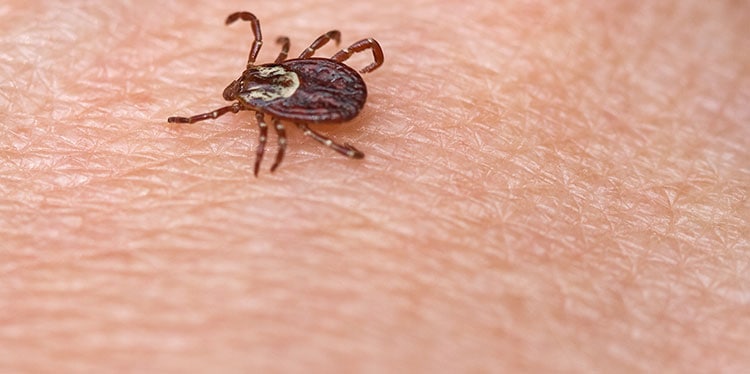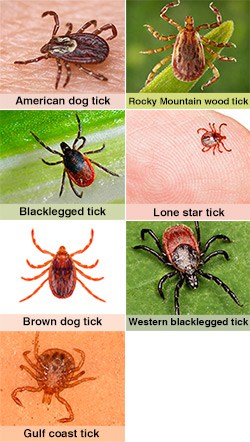It’s tick season! Prevent contact, know the signs and symptoms.

Take preventive measures against ticks year-round, especially in the warmer months from April to September, when ticks are most active.
How can I avoid contact with ticks?
- Avoid wooded and brushy areas with high grass and leaf litter.
- Walk in the center of the trails. Avoid walking off the trail.
What repellent should I use?
- Use a repellent containing 20 percent or more DEET, Icaridin (also known as Picaridin), or IR3535 on exposed skin. Make sure to follow product instructions. Parents should apply this product to their children, avoiding hands, eyes, and mouth.
- Use products containing permethrin on clothing. Treat clothing, boots, pants, socks, and tents with products containing 0.5% permethrin.
What’s the best way to find ticks?
- Bathe or shower as soon as possible after coming indoors to wash off and find ticks that may be crawling on you.
- Do a full-body tick check using a hand-held or full-length mirror to view all parts of your body after returning from possible tick-infested areas. Parents should check their children for ticks under the arms, in and around the ears, inside the belly button, behind the knees, between the legs, around the waist, and especially in their hair.
- Examine gear and pets. Ticks can ride into the home on clothing and pets, then attach to a person later, so examine pets, coats, and backpacks.
- Tumble dry clothes in a dryer on high heat for about 10 minutes to kill ticks on dry clothing.
How do I remove a tick?
If you find a tick attached to your skin, there’s no need to panic! There are several ways to remove a tick, but tweezers will remove a tick quite easily.
- Use tweezers to grasp the tick as close to the skin’s surface as possible.
- Pull upward with steady, even pressure. After removing the tick, clean the area and your hands with rubbing alcohol, an iodine scrub, or soap and water.
- Dispose of a live tick by submerging it in alcohol and placing it in a sealed bag or container. Avoid flushing it down the toilet. Ticks have a tendency to survive and it’s also helpful for your doctor to see the actual tick to determine the best course of treatment.
What are the symptoms of a tick-related illness?
If you have been bitten by a tick and develop the symptoms below within a few weeks, your doctor or provider will evaluate the following symptoms before deciding on the best course of treatment.
The most common symptoms of tick-related illnesses are:
- Fever/chills
- Aches and pains: Tick-related symptoms include headache, fatigue, and muscle aches. With Lyme disease, you may also experience joint pain. The severity and time of onset of these symptoms may depend on the type of tick and personal tolerance level.
- Rash
- Lyme disease. The rash may appear within 3-30 days, typically before the onset of fever. Lyme disease rash is the first sign of infection and is usually a circular rash called erythema migrans. This rash begins at the site of a tick bite. It may be warm to the touch but is not usually painful. Some people develop additional lesions in other areas of the body several days later.
- Southern tick-associated rash illness is almost identical to Lyme disease, with a red, expanding “bull’s eye” lesion that develops around the site of a tick bite. Unlike Lyme disease, this rash has not been linked to any arthritic or neurologic symptoms.
- Rocky Mountain spotted fever varies from person to person in appearance, location, and time of onset. About 10% of people never develop a rash. Most often, the rash begins 2-5 days after the onset of fever. It appears as small, flat, pink, non-itchy spots on the wrists, forearms, and ankles and spreads to the trunk. This red-to-purple, spotted rash is usually not seen until the sixth day or later after the onset of symptoms and occurs in 35-60% of people with the infection.
- Tularemia, a skin ulcer, appears at the site where the organism enters the body. The ulcer also includes swelling of the lymph glands, usually in the armpit or groin.
- Ehrlichiosis can cause a rash. The rash ranges from macular to maculopapular to petechial and may appear after the onset of fever.
Although easily treated with antibiotics, these diseases can be difficult for physicians to diagnose. Early recognition and treatment of the infection decrease the risk of serious complications. See your doctor immediately if you have been bitten by a tick.
Where are ticks found?
American dog tick
 The American dog tick is found east of the Rocky Mountains, as well as in limited areas on the Pacific Coast. This tick transmits Tularemia and Rocky Mountain spotted fever. The highest risk of being bitten occurs during spring and summer. Dog ticks are also called wood ticks.
The American dog tick is found east of the Rocky Mountains, as well as in limited areas on the Pacific Coast. This tick transmits Tularemia and Rocky Mountain spotted fever. The highest risk of being bitten occurs during spring and summer. Dog ticks are also called wood ticks.Blacklegged tick
The black-legged tick is found in the Northeastern and upper Midwestern United States. This tick transmits Lyme disease, anaplasmosis, babesiosis, and Powassan disease. The highest risk of being bitten exists in the spring, summer, and fall. The adults have been known to search for a host any time winter temperatures are above freezing.
Brown dog tick
The Brown dog tick can be found worldwide. This tick transmits Rocky Mountain spotted fever in the Southwestern U.S. and along the U.S.-Mexico border. Dogs are the main host for the brown dog tick, but the tick may also bite humans or other mammals.
Gulf Coast tick
The Gulf Coast tick can be found in coastal areas of the U.S. along the Atlantic coast and the Gulf of Mexico. This tick transmits Rickettsia parkeri rickettsiosis, a form of spotted fever.
Lone Star tick
The Lone Star tick can be found in the Southeastern and Eastern United States. This tick transmits Ehrlichia chaffeensis and Ehrlichia ewingii which cause human ehrlichiosis, tularemia, and Southern tick-associated rash illness. This is a very aggressive tick that bites humans. The adult female has a white dot or “lone star” on her back.
Rocky Mountain wood tick
The Rock Mountain wood tick can be found in Rocky Mountain states and Southwestern Canada. This tick transmits Rocky Mountain spotted fever, Colorado tick fever, and tularemia.
Western black-legged tick
Western black-legged ticks can be found along the Pacific coast of the U.S., particularly northern California. This tick transmits Anaplasmosis and Lyme disease.
Additional Resources
- Deer Ticks – MN Department of Natural Resources
- Find the Insect Repellant that is Right for You – Environmental Protection Agency
- Special Topic: Lyme Disease – My Healthy Matters, with Dr. David Hilden
- Lyme Disease – Outdoor Safety Tips from HCMC, HCMC YouTube Channel
- Tickborne Diseases of the United States – Centers for Disease Control and Prevention
- Tickborne Diseases – MN Department of Health

